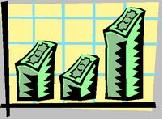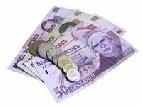
 |
|
| Financial Terms | |
| Variable |
|
Information about financial, finance, business, accounting, payroll, inventory, investment, money, inventory control, stock trading, financial advisor, tax advisor, credit.
Main Page: stock trading, financial, finance, business, credit, inventory, accounting, investment, Also see related: credit, homebuyer, home, mortgage, condo, insurance, homes, buy home, home insurance, |
Definition of Variable
VariableA value determined within the context of a model. Also called endogenous variable.
Related Terms:Continuous random variableA random value that can take any fractional value within specified ranges, as Discrete random variableA random variable that can take only a certain specified set of discrete possible Endogenous variableA value determined within the context of a model. Exogenous variableA variable whose value is determined outside the model in which it is used. Also called Normal random variableA random variable that has a normal probability distribution. Random variableA function that assigns a real number to each and every possible outcome of a random experiment. Variable annuitiesAnnuity contracts in which the issuer pays a periodic amount linked to the investment  Variable costA cost that is directly proportional to the volume of output produced. When production is zero, Variable life insurance policyA whole life insurance policy that provides a death benefit dependent on the Variable price securityA security, such as stocks or bonds, that sells at a fluctuating, market-determined price. Variable rate CDsShort-term certificate of deposits that pay interest periodically on roll dates. On each roll Variable rated demand bond (VRDB)Floating rate bond that can be sold back periodically to the issuer. Variable rate loanLoan made at an interest rate that fluctuates based on a base interest rate such as the VARIABLE EXPENSESThose that vary with the amount of goods you produce or sell. These may include utility bills, labor, etc. Semi-variable costsCosts that have both fixed and variable components. Variable costA cost that increases or decreases in proportion with increases or decreases in the volume of production of goods or services.  Variable costingA method of costing in which only variable production costs are treated as product costs and in which all fixed (production and non-production) costs are treated as period costs. variable expensesExpenses that change with changes in either sales volume decision variablean unknown item for which a linear programming dependent variablean unknown variable that is to be predicted independent variablea variable that, when changed, will key variablea critical factor that management believes will slack variablea variable used in a linear programming problem surplus variablea variable used in a linear programming problem that represents overachievement of a minimum requirement; it is associated with greater-than-or-equal-to constraints variable costa cost that varies in total in direct proportion variable costinga cost accumulation and reporting method variable cost ratiothe proportion of each revenue dollar variable overhead efficiency variancethe difference between budgeted variable overhead based on actual input activity and variable overhead applied to production variable overhead spending variancethe difference between total actual variable overhead and the budgeted amount of variable overhead based on actual input activity Variable costA cost that changes in amount in relation to changes in a related activity. variable costsCosts that change as the level of output changes. Variable AnnuityA form of annuity policy under which the amount of each benefit is not guaranteed or specified. The amounts fluctuate according to the earnings of a separate investment account. Ordinary least squares (OLS)regression analysis a statistical technique that minimizes the sum of the squared deviations between a dependent variable and one or more independent variables and provides the user Alternative mortgage instrumentsVariations of mortgage instruments such as adjustable-rate and variablerate AutocorrelationThe correlation of a variable with itself over successive time intervals. Coefficient of determinationA measure of the goodness of fit of the relationship between the dependent and Contribution marginThe difference between variable revenue and variable cost. Correlation coefficientA standardized statistical measure of the dependence of two random variables, CovarianceA statistical measure of the degree to which random variables move together. Cumulative probability distributionA function that shows the probability that the random variable will Equity-linked policiesRelated: variable life Floating-rate contractA guaranteed investment contract where the credit rating is tied to some variable Interest rate swapA binding agreement between counterparties to exchange periodic interest payments on Inverse floating rate noteA variable rate security whose coupon rate increases as a benchmark interest rate declines. LagPayment of a financial obligation later than is expected or required, as in lead and lag. Also, the number LIBORThe London Interbank Offered Rate; the rate of interest that major international banks in London Log-linear least-squares methodA statistical technique for fitting a curve to a set of data points. One of the Lognormal distributionA distribution where the logarithm of the variable follows a normal distribution. Long runA period of time in which all costs are variable; greater than one year. Long runA period of time in which all costs are variable; greater than one year. MeanThe expected value of a random variable. Measurement errorErrors in measuring an explanatory variable in a regression that leads to biases in Moving averageUsed in charts and technical analysis, the average of security or commodity prices Multiple regressionThe estimated relationship between a dependent variable and more than one explanatory variable. Normal probability distributionA probability distribution for a continuous random variable that is forms a ParameterA representation that characterizes a part of a model (e.g. a growth rate), the value of which is PlugA variable that handles financial slack in the financial plan. Probability density functionThe probability function for a continuous random variable. Probability distributionAlso called a probability function, a function that describes all the values that the random variable can R squared (R^2)Square of the correlation coefficient proportion of the variability explained by the linear Regression analysisA statistical technique that can be used to estimate relationships between variables. Regression equationAn equation that describes the average relationship between a dependent variable and a Regression toward the meanThe tendency for subsequent observations of a random variable to be closer to its mean. Residuals1) Parts of stock returns not explained by the explanatory variable (the market-index return). They Serial covarianceThe covariance between a variable and the lagged value of the variable; the same as Simple linear regressionA regression analysis between only two variables, one dependent and the other explanatory. Tactical Asset Allocation (TAA)An asset allocation strategy that allows active departures from the normal Technical descriptorsvariables that are used to describe the market on a technical basis. VolatilityA measure of risk based on the standard deviation of investment fund performance over 3 years. Absorption costingA method of costing in which all fixed and variable production costs are charged to products or services using an allocation base. ContributionAlso the difference between the selling price and variable costs, which can be expressed either per Cost behaviourThe idea that fixed costs and variable costs react differently to changes in the volume of Optimum selling priceThe price at which profit is maximized, which takes into account the cost behaviour of fixed and variable costs and the relationship between price and demand for a product/service. Sensitivity analysisAn approach to understanding how changes in one variable of cost–volume–profit analysis are affected by changes in the other variables. contribution marginAn intermediate measure of profit equal to sales revenue gross margin, or gross profitThis first-line measure of profit overhead costsOverhead generally refers to indirect, in contrast to direct, revenue-driven expensesOperating expenses that vary in proportion to unit marginThe profit per unit sold of a product after deducting product Correlation CoefficientA measure of the tendency of two variables to change values Expected ValueThe value of the possible outcomes of a variable weighted by the Standard DeviationA statistical term that measures the dispersion of a variable absorption costinga cost accumulation and reporting break-even charta graph that depicts the relationships among revenues, variable costs, fixed costs, and profits (or losses) carrying costthe total variable cost of carrying one unit of coefficient of correlationa measure of dispersion that indicates the degree of relative association existing between two variables contribution marginthe difference between selling price and contribution margin ratiothe proportion of each revenue dollar remaining after variable costs have been covered; correlation analysisan analytical technique that uses statistical cost containmentthe practice of minimizing, to the extent cost structurethe relative composition of an organization’s direct costingsee variable costing high-low methoda technique used to determine the fixed input-output coefficienta number (prefaced as a multiplier integer programminga mathematical programming technique in which all solutions for variables must be restricted to whole numbers least squares regression analysisa statistical technique that investigates the association between dependent and independent variables; it determines the line of "best fit" for a set of observations by minimizing the sum of the squares linear programminga method of mathematical programming used to solve a problem that involves an objective function and multiple limiting factors or constraints long-term variable cost a cost that was traditionally viewed as a fixed cost mixed costa cost that has both a variable and a fixed component; multiple regressiona statistical technique that uses two or Related to : financial, finance, business, accounting, payroll, inventory, investment, money, inventory control, stock trading, financial advisor, tax advisor, credit. |